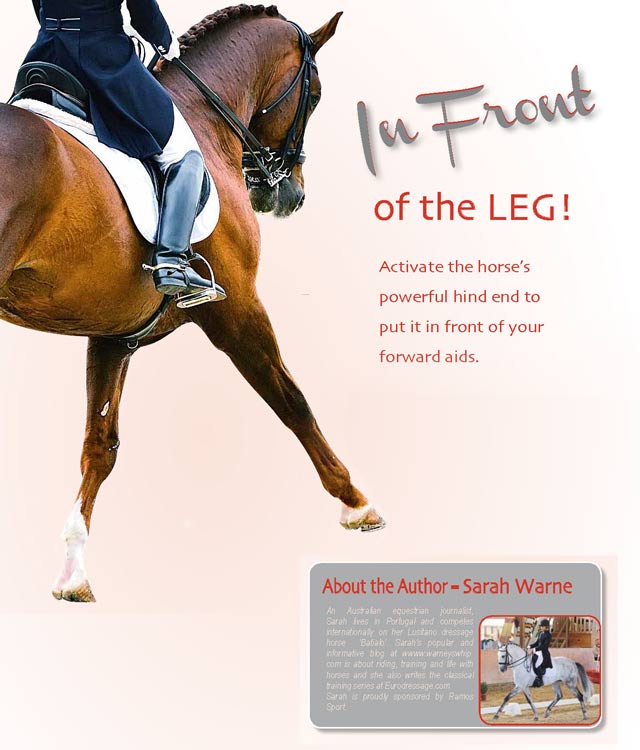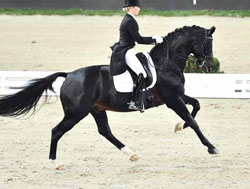|

We have all heard the term “Put the horse in front of your leg”, and while some may scratch their heads and wonder what you are talking about, others may think it sounds simple. While it is not difficult to explain just what this means, it is very difficult to achieve correctly.
Unfortunately, it does not mean getting off and shifting the saddle back, if only it were that easy!
Putting the horse in front of the leg means, of course, that the horse is engaged, underneath you, and that when you give an aid it reacts by stepping forward, coming up from behind and into an elastic hand contact in front. You get the feeling that the horse steps up a hill, and “out the front door” as you have taken control of his powerful hind end.
I try to think that when I ask a leg aid; the energy of the horse comes through him and out the top, as opposed to out behind or split down the middle.
If a horse is behind your leg it almost feels as if your sitting in a gap in the middle of him, with half out the back and half out the front, and when you give an aid there is no flow of energy, just you banging about in the middle.
A quick check to determine if your horse is in front of your leg is to select 1, 2 or 3:
1: My horse accepts my light leg aid and instantly responds.
2. My horse is lazy so I have to kick a lot to keep him motivated.
3. My horse is very hot, sensitive, he runs too fast and is too much in front of the leg, so I just take my leg off.
Those who selected option 1 are on the right track; 2 and 3 may need to go back a step in training and teach the horse to accept the leg and be reactive to the aid.
If a horse is in front of the rider’s leg when a relaxed effective aid is given, you can feel that immediate reaction and the activity occuring from behind, which pushes the energy forward and lengthens the horse’s neck into a steady contact with the rider’s hands.
 The halt is actually the best demonstration of ‘in front of the leg’ because horses will step up and halt square if they are in front of the rider’s leg. If they are behind, they will step back or out. The halt is actually the best demonstration of ‘in front of the leg’ because horses will step up and halt square if they are in front of the rider’s leg. If they are behind, they will step back or out.
It has to be quick behind and long in front, as opposed to long behind and short in front!
So how to tell if your horse is in front of your leg? And how then, if he is not, to get him there?
When my trainer, Miguel Ralao, first came to see me ride Batialo, I felt like I was flying around in a big trot, but he quickly pointed out that not only was I working too hard, kicking every step, but also when I gave the aid for more impulsion, Batialo was getting longer and flatter, as opposed to shorter and more energetic.This was, of course, because the energy was going everywhere, out the back, through the sides, into the shoulders, everywhere except UP!
To correct this we had to get Batialo back in front of the leg, so that when the aid for more impulsion was given, the energy could go up and out the front door.
TRANSITIONS
So we began transitions, going on and coming back, within the gait, or from trot to walk, to make sure Batialo was moving off a light aid, and stretching forward into the contact, being careful not to let him flatten and lengthen but keep himself round over the back.
Sounds simple, but the problem is that many riders think they have the horse in front of the leg, but when they go to ask for that next exercise, they realise that they don’t at all.
The walk is one of the most difficult gaits to tell if the horse is in front of the leg, and often we see riders give an aid in the walk, and watch as the horse quickens or shuffles his feet instead of lengthening his stride and swinging his back.
 The horse will activate the hind end, it will feel like it is going uphill and the energy will flow back to the rider’s hands. The horse will activate the hind end, it will feel like it is going uphill and the energy will flow back to the rider’s hands.
The proof that a rider does not have the horse in front of the leg will be seen most obviously in the walk to canter transition, and you will often see that a rider will give the aid to canter, and the horse will either, quicken the walk, trot, drop onto the shoulders, or avoid the aid and move off the outside leg.
If the horse moves off a light leg aid, jumps up into the canter, engages from behind and stretches into the contact, the balance of the canter is established from the very first step, and the rider knows her horse is in front of the leg.
Then, if you have your horse in front of the leg, you need to keep him there.
This means that you need to make sure that when you give an aid, the horse has a reaction; again, dressage is about relativity, and if you don’t get a reaction from a light aid, the most common rider error is to the then ask harder, and harder, and more and more and more, until the rider is a sweaty mess of frustration and the horse looks like he has gone on holiday.
If you don’t get a reaction, ask, “What did I want, and why didn’t I get it?”
Stop, ask the horse to move off a light leg aid, reward when he does, and then go again.
While dressage is about relativity, lucky for us it is not a race, and going around and around will often not solve the problem.
Take a moment, breathe, and start again.
While you can’t stop and put the saddle to the back, you can stop and put your mind back into “in front of my leg, and off a light aid” mode!
TOPICS available online by Dr Jennifer Stewart
Vol 42 - 1 June July 20
WHEN A SNOTTY NOSE ISN'T JUST A SNOTTY NOSE-
Vol 41 - 6 April May 20
PAIN IN THE JOINTS - Equine arthritis
Vol 41 - 5 Feb/March 20
ANAEMIA
Vol 41 - 4 December January 2019/20
PNEUMONIA
Vol 41 - 2
LYME DISEASE IN AUSTRALIA
Vol 41 - 1
I CAN HEAR SAND
Vol 40 - 6
LAMENESS
Vol 40 - 4
STRESS - how do we know if our horse is stressed?
Vol 30 - 1
STIFLE LOCK
with the Equine Veterinarians Australia (EVA)
Vol 27 - 4
ROSS RIVER VIRUS
Vol 36 - 6
BIOSECURITY
Vol 31 - 5
BIG HEAD
Vol 35-6
WHAT CONTROLS APPETITE IN HORSES?
Vol 35 - 4
BEHAVIOUR OR PMS
|